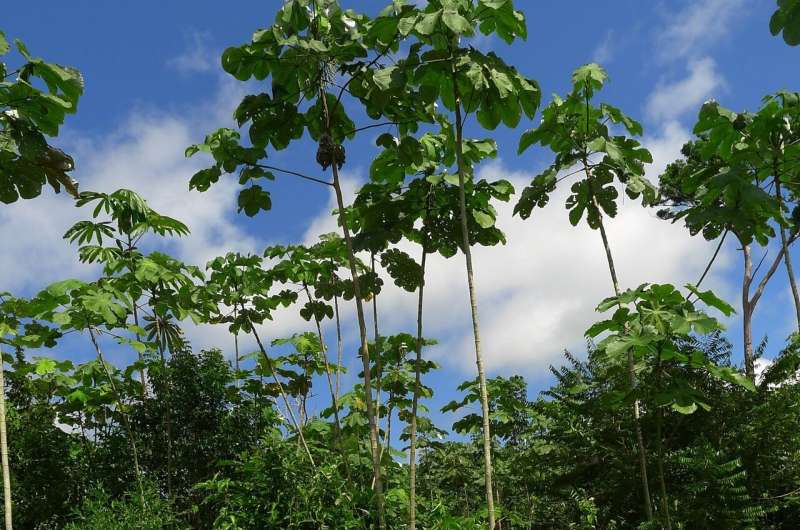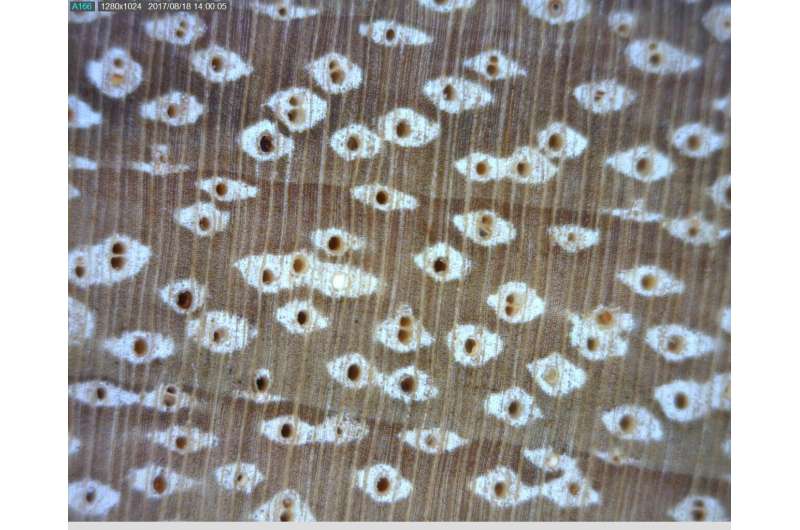Wet and dry tropical forests show opposite pathways in forest recovery

The composition of regrowing wet and dry tropical forests follow opposite pathways while these forests age. This fact has significant consequences for forest restoration initiatives. The findings of a new study published this week in Nature Ecology & Evolution provide insights to select the best tree species for a forest area, thus enhancing and accelerating tropical forest restoration success.
Tropical forests can regrow naturally after agricultural fields are abandoned. During this regrowing process, called succession, the vegetation gradually builds up, leading to changes in environmental conditions at the forest floor. And because species differ in their growing strategies, this leads to shifts in species composition over time. Understanding how succession works is crucial to improve forest restoration initiatives and to select the best species for planting.
Soft woods have a rock-and-roll life style
A large team of ecologists from Latin America, United States, Australia and Europe followed recovery of tropical forests in fifty locations across ten Latin American countries. This 2ndFOR research team found that wet and dry forests show opposite successional pathways. "Species with different characteristics thrive under different environmental conditions," says Prof. Lourens Poorter from Wageningen University & Research and lead author of the study. "A key characteristic of tree species is their stem wood density. Species that produce soft and cheap wood have the ability to grow very fast when light and water are abundant. However, this soft wood comes at the expense of a reduced survival, especially under suboptimal conditions like shade and drought. As a result, soft-wooded species have a 'rock-and-roll' life style—they peak early in life, live fast and die young."
On the other hand, species that produce durable and expensive wood can persist for a very long time, especially under adverse conditions, the research team describes in their paper. This strategy comes at the expense of a reduced and slow growth. These results provide an important step to understand the shift in species composition during forest succession. The successional theory predicts that early in succession, light and water resources are in abundant supply, which leads to the dominance of 'fast' pioneer species with soft wood. Later in the succession however, resource availability declines, leading to the dominance of 'slow' late-successional species with hard wood, like Maçaranduba (Manilkara bidentata) a Neotropical timber species that produces such heavy wood that it sinks in water.

Shift from soft to hard wood species in wet forests
To evaluate successional changes in wood density, the research team analysed forest recovery at an unprecedented spatial scale, using original data from 50 sites, 1,400 plots and more than 16,000 trees from tropical forests across Latin America. Co-author Dr. Danae Rozendaal says: "Our results show that in wet forest we indeed see a shift from soft- to hard-wooded species over time. However, in dry forest we see an opposite shift from hard- to soft-wooded species."
Opposite trend in dry forests
This opposite trend happens because in wet forests, resources (e.g. light) decline during succession, whereas in dry forests initial conditions are very harsh, dry and hot. Only hard-wooded species can tolerate these extreme conditions. When they grow they create a milder micro environment, which paves the way for the establishment of soft-wooded species. "Intriguingly", Danae Rozendaal adds, "the results show that wet and dry forests start out very differently, but become more similar over time in terms of microclimate and species wood density."
Tree species selection for forest recovery
"The new ecological insights can be used to improve species selection for restoration," Wageningen Professor Frans Bongers assures. "Where possible, forest restoration should rely on natural regeneration, as it is cheaper, and leads to a more diverse and resilient vegetation. However, in degraded areas where natural regeneration is difficult, active planting provides a good alternative. Our findings suggest that forest restoration in areas with an intense dry season, covering 16% of Neotropical forests, should prioritize planting species with high wood density. These have greater chances of surviving the dry period. In addition, well-adapted, native tree species are preferred rather than exotic species because they support biodiversity. This selection can also lower mortality rates among planted trees, which often exceeds more than one third of these planted trees. In wet forests though, a mix of local soft and hard wooded species can be successfully planted at the outset. The fast soft-wooded species rapidly establish a protecting vegetation, and shelter the slower growing hard-wooded species that will form the basis of a long-term stable forest."
More information: Lourens Poorter et al. Wet and dry tropical forests show opposite successional pathways in wood density but converge over time, Nature Ecology & Evolution (2019). DOI: 10.1038/s41559-019-0882-6
Journal information: Nature Ecology & Evolution
Provided by Wageningen University

















